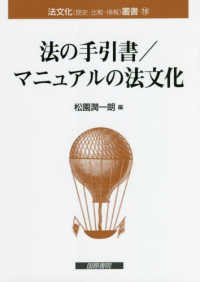Full Description
Athletic trainers have a responsibility to provide high-quality pharmaceutical care while meeting both legal and ethical requirements. Clinical Pharmacology in Athletic Training empowers athletic trainers with a functional understanding of pharmacology that enables them to formulate a treatment plan intended to mitigate disease and improve the overall health of their patients. This text incorporates the most up-to-date content from the 2020 Commission on Accreditation of Athletic Training Education (CAATE) standards, and it emphasizes interprofessional practice to enable future and current athletic trainers to collaborate with other health professionals in a manner that optimizes the quality of care.
Clinical Pharmacology in Athletic Training begins by addressing drug legislation and the legal aspects of the athletic trainer's role in sport medication. The text provides an overview of pharmacokinetics and pharmacodynamics with an emphasis on concepts relevant to clinical practice. Students are introduced to the generic and brand names, general classifications, and appropriate administration of drugs and are guided toward appropriate online reference materials. Part II of this text describes common medications for pain, inflammation, and infections. Part III includes medications for specific conditions, including respiratory, cardiovascular, gastrointestinal, neurological, gynecological, and mental health conditions. The text also includes current information on opioid analgesics, cannabis, and cannabinoid-based medications.
Clinical Pharmacology in Athletic Training teaches students to administer appropriate pharmacological agents for the management of the patient's condition. The information includes indications, contraindications, dosing, interactions, and adverse reactions. The following features are included to aid in the learning process:
Chapter objectives set the stage for the main topics covered in the chapter.
Key terms are boldfaced to indicate terms of special importance, and a glossary of definitions is included at the back of the book.
Red Flag sidebars highlight warnings and precautions for certain medications or medicolegal issues.
Evidence in Pharmacology sidebars highlight recent research regarding medications.
Clinical Application sidebars present real-life stories from the field of athletic training.
Case studies highlight specific therapeutic medication applications and are accompanied by questions that prompt readers to think critically about the issues presented.
Quick reference drug tables describe medication types, generic and brand names, pronunciations, common indications, and other special considerations for the athletic trainer.
Over the past decade, there has been an increased emphasis on pharmacology in athletic training. Clinical Pharmacology in Athletic Training will equip students with appropriate skills and competencies, prepare them to meet patient needs, and enable them to work in interprofessional teams.
Contents
Part I. Foundational Pharmacology Concepts
Chapter 1. Legal Aspects of Therapeutic Medication Management
Health Care Providers With Prescribing Authority
The Sports Medicine Team
Federal and State Laws
Drug Development, Studies, and Standards
Summary
Case Studies
Chapter 2. Administering Medications in the Athletic Training Setting
Athletic Training Clinic
Guidelines for Administering Medications
Preventing Medication Errors
Summary
Case Studies
Chapter 3. Drug Names, Classification, and Safety
Drug Names
Drug Classes
Drug Safety
Adverse Drug Effects and Therapeutic Monitoring
Allergic Drug Reactions
Medication Use Process
Drug Information Resources
Summary
Case Studies
Chapter 4. Pharmacokinetics
Biopharmaceutics
Drug Liberation
Drug Absorption
Drug Distribution
Drug Metabolism
Drug Elimination
Pharmacokinetics and Exercise
Summary
Case Studies
Chapter 5. Pharmacodynamics
Mechanism of Action
Drug Receptors
Drug-Receptor Binding
Drug-Receptor Interactions
Drug Dosing
Dose Responses
Summary
Case Studies
Chapter 6. Drug Delivery, Dosages, and Procedures
Drug Delivery Systems
Routes of Administration
Enteral Drug Delivery
Parenteral Drug Delivery
Mucous Membrane Drug Administration
Topical Drug Administration
Transdermal Drug Administration
Medication Dosing
Clinical Procedures for Enteral Drug Administration
Summary
Case Studies
Part II. Classes of Therapeutic Medications
Chapter 7. Drugs to Treat Pain: Nonopioid Analgesics and Anesthetics
Biopsychosocial Model
Differentiation of Pain
Pathophysiology of Pain
Analgesics
Nonopioid Analgesic Agents
Local Anesthetics
Topical Analgesics: Creams, Gels, and Ointments
The ATs' Role in the Clinical Management of Pain
Summary
Case Studies
Chapter 8. Drugs to Treat Pain: Opioid Analgesics
Appropriate Use of Opioid Analgesics
Classes of Opioid Analgesics
Summary
Case Studies
Chapter 9. Drugs to Treat Inflammation: Steroidal and Nonsteroidal Anti-Inflammatories
Inflammatory Process
Controlling Inflammation
Corticosteroids
Nonsteroidal Anti-Inflammatory Drugs
Summary
Case Studies
Chapter 10. Drugs to Treat Infection: Antibiotics
Indications for Use
Mechanism of Action
Therapeutic Effects
Routes of Administration
Pharmacokinetics
Pharmacodynamics
Dosing Guidelines
Adverse Effects
Indications and Precautions
Patient Education for Use of Antibacterial Medications
Summary
Case Studies
Part III. Drugs for Treating Common Conditions
Chapter 11. Drugs for Treating Asthma and Other Respiratory Conditions
Respiratory Infections
Allergic Rhinitis and Other Allergies
Asthma
Summary
Case Studies
Chapter 12. Drugs for Treating Cardiovascular Conditions
Ischemic Chest Pain: Angina Pectoris
Atherosclerosis and Coronary Artery Disease
Acute Coronary Syndrome
Hypertension and Hypertensive Crisis
Cardiac Arrhythmias
Thromboembolisms
Summary
Case Studies
Chapter 13. Drugs for Treating Diabetes and Disordered Glucose Metabolism
Glucose Homeostasis
Metabolic Disorders
Antidiabetic Agents for Managing Type 2 Diabetes Mellitus
Insulin for Managing Type 1 and Type 2 Diabetes Mellitus
Diabetes Care Plan
Summary
Case Studies
Chapter 14. Drugs for Treating Digestive Disorders
Nausea and Vomiting
Diarrhea
Constipation
Gastroesophageal Reflux Disease
Gastritis and Peptic Ulcer Disease
Gastroenteritis
Functional Bowel Disorders: Inflammatory Bowel Disease
Supportive Care and General Management of Digestive Disorders
Summary
Case Studies
Chapter 15. Drugs for Treating Common Musculoskeletal and Neurological Conditions
Articular (Joint) Pain
Musculotendinous Pain
Neck and Back Pain
Fibromyalgia
Complex Regional Pain Syndrome
Headache Disorders
Summary
Case Studies
Chapter 16. Drugs for Treating Dermatological Conditions
Protective Barrier of the Skin
Principles of Topical Dermatologic Pharmacology
Bacterial Skin and Soft-Tissue Infections
Fungal Skin Infections
Candidiasis
Viral Skin Infections: Herpes Simplex and Molluscum Contagiosum
Autoimmune Inflammatory Skin Conditions
Summary
Case Studies
Chapter 17. Drugs for Treating Reproductive and Genitourinary Concerns
Family Planning and Contraception
Short-Acting Hormonal Contraceptives
Long-Acting Reversible Contraception
Barrier Methods
Emergency Contraception
Recommendations for Exercise During Pregnancy
Sexually Transmitted Infections
Reproductive and Urogenital Concerns
Summary
Case Studies
Chapter 18. Drugs for Treating Mental Health Conditions
Mental Health Conditions
Behavioral Health Emergencies
Treatment Options for Mental Health Disorders
Mood Disorders
Anxiety Disorders
Stressor-Related Disorders
Sleep or Wakefulness Disorders
Neurodevelopmental Disorders: Attention-Deficit/Hyperactivity Disorder
Eating Disorders
Substance-Related Disorders
Summary
Case Studies
Chapter 19. Drugs and Supplements to Enhance Performance
Substances Banned for Competition
Supplements for Enhancing Musculoskeletal Performance
Supplements for Treating Neurological Conditions
Supplements for Treating Skeletal Conditions
Manipulation of Approved Medications to Enhance Performance
Summary
Case Studies
Chapter 20. Cannabis and Cannabinoids
Cannabis
Cannabinoids
Acute Effects of Cannabis Use
Chronic Effects of Cannabis Use
Adverse Effects of Cannabis
Cannabidiol
Medical Cannabinoids
Research on Cannabinoid-Based Medicines
Performance Effects and Sport Regulation
Regulation of Cannabis Use
Clinical Recommendations
Summary
Case Studies
Chapter 21. Drug Testing in Sport
Drug Education
The Evolution of Drug Testing in Sport
Supplement Standards
The Drug-Testing Process
Testing for Marijuana
Testing for Anabolic Steroids
Masking Agents
Results of Drug Testing
Drug Exemptions
Summary
Case Studies
Chapter 22. Medications for Surgery
Concepts of Anesthesia
Effects of General Anesthesia
Levels of Sedation
Stages of Anesthesia
Types of Anesthesia
Common Applications of Anesthesia in Sports Medicine
Preparation for a Surgical Procedure
Recovery From a Surgical Procedure
Adverse Effects of Anesthesia
Summary
Case Studies








